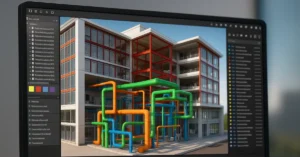Exploring the Synergy: Traditional vs Modern Architecture
In the realm of architecture, the interplay between tradition and modernity has long been a source of fascination and debate. As we step into 2024, this discourse takes on new significance, shaped by evolving societal values, technological advancements, and environmental imperatives. This comprehensive exploration seeks to dissect the complexities of traditional and modern architecture, unraveling their distinct characteristics, shared synergies, and future trajectories.
Traditional Architecture in 2024:

Traditional architecture stands as a testament to the rich tapestry of human history and cultural heritage. Rooted in time-honored practices and local vernacular, traditional buildings reflect the identity, values, and aspirations of communities across the globe. In the landscape of 2024, traditional architecture continues to play a vital role, albeit amidst the challenges of urbanization, globalization, and sustainability.
Characteristics of Traditional Architecture:
- Emphasis on craftsmanship and artisanal techniques
- Utilization of indigenous materials and building methods
- Integration of cultural motifs, symbols, and storytelling elements
Challenges and Opportunities:
- Threats posed by rapid urbanization, gentrification, and cultural homogenization
- Opportunities for heritage conservation, adaptive reuse, and community-led development initiatives
Modern Architecture in 2024:

Modern architecture epitomizes innovation, functionality, and forward-thinking design principles. Characterized by clean lines, geometric forms, and technological integration, modern buildings redefine the urban landscape and challenge conventional notions of space and form. In 2024, modern architecture continues to evolve, driven by advancements in materials, construction techniques, and sustainability practices.
Key Features of Modern Architecture:
- Minimalist aesthetics and streamlined design elements
- Incorporation of cutting-edge technologies such as parametric modeling and digital fabrication
- Focus on sustainability, energy efficiency, and eco-friendly building practices
Technological Advancements:
- Role of digital tools in design visualization, simulation, and optimization
- Integration of smart technologies for enhanced functionality, comfort, and resource management
- Exploration of innovative materials and construction techniques for sustainable building solutions
Bridging Tradition and Modernity:
While traditional and modern architecture may appear diametrically opposed, they share common ground in their pursuit of cultural relevance, societal impact, and environmental sustainability. In the dynamic landscape of 2024, architects and designers are increasingly exploring ways to bridge the gap between tradition and modernity, leveraging the strengths of each approach to create spaces that resonate with meaning and purpose.
Hybrid Architectural Solutions:
- Adaptive reuse of heritage buildings with modern interventions
- Integration of traditional design elements into contemporary structures
- Collaborative approaches that blend cultural heritage with cutting-edge technology and innovation
Sustainable Design Principles:
- Adoption of biophilic design principles to enhance human-nature connection
- Implementation of passive design strategies for energy efficiency and climate resilience
- Embrace of circular economy principles to minimize waste and promote resource conservation
Future Directions and Challenges:
As we look towards the future, the trajectory of architecture in 2024 and beyond is shaped by pressing challenges and transformative opportunities. Architects, urban planners, and policymakers must navigate complex issues such as climate change, urbanization, social equity, and cultural preservation, envisioning solutions that embrace diversity, foster inclusivity, and promote sustainability.
Addressing Climate Change:
- Designing resilient, adaptable, and climate-responsive built environments
- Promoting regenerative design principles to mitigate carbon footprint and promote ecosystem health
- Advocating for policy measures and incentives to support sustainable building practices and green infrastructure development
Embracing Cultural Diversity:
- Celebrating cultural diversity and heritage preservation in architectural design
- Fostering inclusive, participatory design processes that reflect the needs and aspirations of diverse communities
- Promoting cross-cultural exchange and collaboration to enrich architectural discourse and practice
Conclusion:
In conclusion, the discourse surrounding traditional and modern architecture in 2024 encapsulates the dynamic interplay between tradition and innovation, heritage and progress. As architects and designers navigate the complexities of a rapidly changing world, they are tasked with envisioning spaces that transcend temporal boundaries, embrace cultural diversity, and promote environmental stewardship. By embracing the synergies between tradition and modernity, and adopting holistic, inclusive approaches to design and planning, we can chart a course towards a more vibrant, resilient, and sustainable built environment for future generations.
Looking ahead, the future of architecture lies in embracing diversity, fostering collaboration, and embracing a holistic approach to design and planning. Architects must rise to the challenge of addressing pressing global issues such as climate change, urbanization, social equity, and cultural preservation, envisioning solutions that prioritize people, planet, and prosperity.
Through interdisciplinary collaboration, cross-cultural exchange, and innovation, architects can create spaces that not only inspire awe and admiration but also serve as catalysts for positive social change and environmental stewardship. By reimagining the built environment as a reflection of our values, aspirations, and collective humanity, we can pave the way for a more inclusive, equitable, and sustainable future for all.
If you’re interested in learning more about architecture firms in Europe, check out this comprehensive list of the top 50 firms compiled by Archgyan. From innovative startups to long-established industry leaders, this list has it all. Take a look and discover some of the most inspiring and influential architecture firms in Europe today.
If you’re interested in architecture and want to learn more about this amazing field, subscribe to our podcast on youtube
For more SketchUp tutorials, head to https://www.sketchupguru.com










